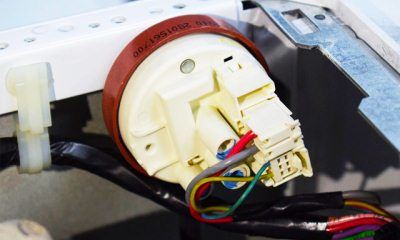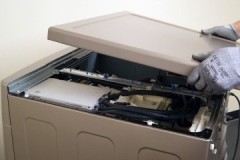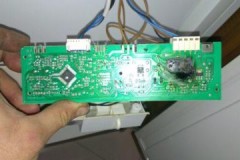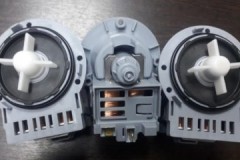Do-it-yourself recommendations for repairing LG direct drive washing machines
 The LG direct drive washing machine is a technique that combines modern design, reliability, and maximum functionality.
The LG direct drive washing machine is a technique that combines modern design, reliability, and maximum functionality.
But like any household appliance, a washing machine requires maintenance. Natural wear and tear of parts and operating errors lead to device failure.
Knowledge of the structure of a washing machine, as well as the most common breakdowns that can disable the device, will help you carry out high-quality home repairs with your own hands.
We will tell you about repairing an LG direct drive washing machine with your own hands below.
Content
How to disassemble the LG washing machine?
You can only get to the failed part by partially or completely disassembling the LG washing machine.
To make the work go quickly, It is important to adhere to a clear algorithm of actions:
-
 We prepare the car for disassembly. To do this, disconnect the equipment from the electrical network, unscrew the intake and drain hoses (located on the rear panel).
We prepare the car for disassembly. To do this, disconnect the equipment from the electrical network, unscrew the intake and drain hoses (located on the rear panel).We drain the remaining water, unscrew the drain filter (hidden behind the hatch at the bottom of the front panel), and move the washing machine away from the wall.
- Remove the top panel. To do this, unscrew the screws (located on the rear panel), lift the cover and, slightly pushing it forward, remove the panel from the body.
- Remove the back panel.It's simple: the service hatch is fixed around the perimeter with bolts that need to be unscrewed.
- Remove the control panel. To do this, pull out the powder receptacle (press the lock located inside the dispenser), and unscrew the screws in the opened niche. Then, using a flat-head screwdriver, bend the latches holding the control panel (do not touch the contacts on the back of the panel).
- We dismantle the front panel. We carry out the work in the following sequence: open the hatch door, pull back the edges of the cuff, remove the retaining clamp, hide the cuff in the drum, unscrew the fasteners holding the UBL. Additionally, we unscrew the fasteners holding the lower part of the front panel (hidden in the niche of the drain filter). The final touch is to unscrew the screws around the perimeter of the front panel and remove it from the washing machine body.
- We dismantle the elements located on top of the tank. First of all, we unscrew the bolts that secure the heavy counterweight blocks (one is located on top of the tank, two are located to the right and left of the hatch). Then we unscrew the screw that secures the detergent dispenser, disconnect the pipe, the contacts leading to the inlet valve. Lastly, disconnect the pressure switch hose from the tank and, unscrewing the fixing elements, remove the drain pump.
- We dismantle the engine. First of all, disconnect the drain pipe. Then we remove the wiring (fastened with special clamps) and unscrew the central screw (fixes the engine cover). The last step is to unscrew the fasteners hidden under the engine cover and remove the unit from the housing.
- We dismantle the heating element. To do this, first disconnect the wiring, then unscrew the central nut (not all the way).Use a metal pin to push the bolt inward, pry up the sealing rubber with a flat screwdriver, and remove the heating element.
- We disassemble the tank and drum. To carry out dismantling quickly, first of all we remove the racks. To do this, we throw a socket wrench with a 14 mm head onto the fastening pin so that the two locking tendrils are compressed. After this, grab the pin with pliers and pull it out of the racks.
We lift the tank and remove it from the hooks. We unscrew the fasteners around the perimeter of the tank. We open the tank into two parts. We set the upper one aside, and from the lower one, lightly tapping the bushing with a hammer, remove the drum.
Disassembly of the LG washing machine is completed!
TOP 10 faults
Information about malfunctions specific to an LG washing machine with direct drive will help you quickly and independently restore the working condition of the household appliance.
The water in the tank does not heat up
 The main reason for cold water in the tank is failure of the heating element. Salts and minerals, which are saturated with tap water, settle on the tubes of the heating element.
The main reason for cold water in the tank is failure of the heating element. Salts and minerals, which are saturated with tap water, settle on the tubes of the heating element.
Over time, the scale layer thickens, which leads to overheating of the internal filler of the heating element.
It’s easy to diagnose a heating element’s malfunction: just touch the hatch door ten minutes after starting the wash at high temperatures. The door is cold - the heating element is faulty. Testing the element with a multimeter (working value 20 ohms) will help confirm assumptions about the breakdown of the heating element.
Solution to the problem: replacing the faulty heating element. The heating element is located at the bottom of the tank. In order to dismantle the element, it is necessary to disconnect the contacts, unscrew the central nut, and remove the grounding wire.
By prying off the rubber seal, the faulty heating element is removed, and a new heating element is fixed to the cleaned seat. Why the LG washing machine does not heat the water, how to find the problem and fix it, read Here, how to replace the heating element - here.
The device does not start
There are several reasons why the washing machine does not start after being plugged in:
- very low voltage (according to regulations, the voltage in the network should not be less than 200V);
- the socket, power cord or plug on the washing machine has failed;
- problems with the control unit.
To return the washing machine to working condition, first of all, check the voltage in the network (use a multimeter tester). If the voltage indicator is normal, the next step is to check the plug and power cable of the washing machine (the device is connected to another outlet).
Why the LG washing machine does not turn on, what to do, he will tell you this article.
Water does not fill into the drum
 The first thing that needs to be checked in a situation where water does not flow into the drum is the water pressure in the tap. Lack of pressure can cause a closed tap (just open it completely and the problem is solved).
The first thing that needs to be checked in a situation where water does not flow into the drum is the water pressure in the tap. Lack of pressure can cause a closed tap (just open it completely and the problem is solved).
Another reason for the lack of water intake into the drum is an inlet filter clogged with debris. To remove blockages, you need to unscrew the water supply hose and thoroughly clean the metal mesh located at the inlet.
A faulty inlet valve is another reason why water is not flowing into the tank. In order to determine the malfunction of this element, you need to:
- Turn off the water and remove the inlet hose.
- Remove the top panel (after unscrewing the fasteners on the rear wall).
- Remove the clamps and disconnect the intake valve terminals.
- Using a multimeter, check the valve coil winding resistance reading.
If there is resistance, the valve is cleaned and installed in its original place. There is no resistance - the inlet valve must be replaced. What are the reasons that the LG washing machine does not draw water well or does not do so at all? this article.
Doesn't drain water
One of the reasons why there is still water in the tank at the end of the wash cycle is that the drain pump is clogged with debris. A step-by-step diagnosis will help determine whether this is so.
First, check and clean the drain filter (hidden in the lower part of the front panel behind a special hatch). The filter is unscrewed and thoroughly washed under running water.
Through the opened hole, inspect the pump impeller and turn it manually. Stiff rotation indicates that the impeller is clogged with debris and needs to be cleaned. Additionally, dismantle and wash the drain hose under the tap.
If cleaning the drain pump does not lead to the desired result, then it is necessary to check the functionality of the pump.
For this:
- disconnect the washing machine from the electricity network, water supply and sewerage;
- lay the household appliance on its side;
- test the drain pump with a multimeter.
Instructions for replacing the pump in an LG washing machine yourself - in this article.
The drum does not spin
Failure of the Hall sensor (responsible for the motor rotation speed) is the reason why the drum does not spin in a direct drive washing machine.
You can troubleshoot the problem as follows:
 The washing machine is disconnected from the electrical network, the drain and inlet hoses are dismantled.
The washing machine is disconnected from the electrical network, the drain and inlet hoses are dismantled.- Remove the back panel
- Unscrew the central bolt holding the engine cover.
- Unscrew the bolts located under the cover and dismantle the stator.
- Unscrew the fasteners and terminals, remove the Hall sensor, and install a new one with similar parameters.
A malfunction of the Hall sensor will be indicated not only by the drum stopping, but also by an unpleasant cracking sound that appears when starting the washing machine.
Noise and grinding noise during the washing process
Bearing failure is a common problem with direct drive washing machines. The thing is that the motor, fixed to the washing machine tank, puts additional load on the bearing assembly, which is why it will quickly collapse.
Signs of malfunction: strong rumble and creaking, accompanying the process of washing and spinning (with increasing drum rotation speed, the sounds intensify).
In order to carry out the replacement, you need to disassemble the washing machine, dismantle the tank, open it into two parts, pull out the oil seal and carefully knock out the bearings. New bearings (exactly corresponding to the parameters of the dismantled elements) are placed in the cleaned seat, after which the washing machine is reassembled.
Do-it-yourself guide to replacing the bearing in an LG washing machine - in this The article will tell you why the washing machine makes a lot of noise during the spin cycle. this article.
Leaking
Violation of the tightness of the rubber seal around the hatch (cuffs), drain or inlet hose, pipes leads to the fact that puddles begin to collect around the washing machine during the washing process.
The exact location of leaks can only be determined by visual inspection. Having established which element is leaking, all that remains to be done is to replace the worn one with a new one that is suitable in terms of parameters and technical characteristics.
Why does an LG washing machine leak, read Herewhy is it flowing from the tray - here, water flows from below - here.
Doesn't wring out
 There are several reasons for this problem: from a banal error in choosing a washing mode to a more serious one - failure of the pressure switch.
There are several reasons for this problem: from a banal error in choosing a washing mode to a more serious one - failure of the pressure switch.
If the washer does not spin out water after washing, first of all you need to make sure whether the spin mode is provided in the selected program. If yes, then you need to check the pressure switch.
It is this sensor that monitors the water level in the tank. A faulty pressure switch provides incorrect data about how full the tank is with water, causing the control module to block the spin process.
It’s easy to check (and if necessary replace) the pressure switch. It is enough to dismantle the top panel, under which the pressure switch is attached in the upper left corner. The sensor is tested with a multimeter and, if necessary, replaced with a new one of similar technical characteristics. Why the LG automatic washing machine does not spin clothes, what to do, read Here.
Problems with hatch locking
A situation where the washing machine does not block the hatch door (thus preventing the washing process from starting) can be triggered by a malfunction of the UBL (hatch locking device).
Replacing UBL is not difficult: just unscrew the screws securing the lock (located on the right side of the loading hatch), remove the UBL (to confirm the malfunction, the lock is tested with a multimeter), unhook the contacts, install and connect a new UBL.
Strong vibration
Very strong vibration of the washing machine during washing, rinsing or spinning clothes is not in itself a malfunction. But ignoring the problem can lead to very serious negative consequences for the functioning of all elements of the household appliance.
Vibration can be caused by:
- Transport bolts (fix the tank while the washing machine is being transported, must be removed).
- Drum loading errors (dirty laundry collected in a lump, overloaded). Due to excessive load, the drum, shock absorbers and other adjacent elements quickly fail.
What to do if there is strong vibration in the LG washing machine during the spin cycle, read Herewhy does it jump during the spin cycle? here.
Call the master
Depending on the type of malfunction, washing machine repair The service center technician will cost:
 replacement of heating elements from 1800 rubles;
replacement of heating elements from 1800 rubles;- replacement of the drain pump from 2100 rubles;
- diagnostics and repair of the control module from RUB 2,600;
- replacement of bearing assembly from RUB 4,500;
- cuff replacement from RUB 2,100;
- replacement of UBL from 1700 rubles;
- engine repair from RUB 2,700;
- cleaning the drainage tract from 1400 rubles;
- replacement of filler valve from 2000 rub.
The amount to pay for the services of the master does not take into account the cost of new parts.
When submitting an application (contacts of private craftsmen and service centers are easy to find on the Internet), only the preliminary cost of services is announced. The final amount can only be announced after a detailed inspection and diagnostics of faults in household appliances.
Video on the topic of the article
How to disassemble an LG direct drive washing machine and replace bearings, video instructions:
Conclusion
Understanding the process of disassembling a washing machine, as well as eliminating the most common faults, helps restore the functionality of such a necessary household appliance.


